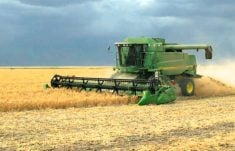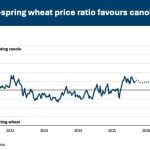Two weather forecasters are calling for an early fall frost, which could have devastating consequences for the delayed 2013 crop.
Drew Lerner, president of World Weather Inc., said three separate weather patterns are “more or less in agreement” that the first week to 10 days of September is the most favoured period for a frost scare in Western Canada.
“It doesn’t mean that there will be a freeze. It doesn’t mean there will be a frost. But it does mean that that’s the next opportunity for a threat of such conditions,” he said.
Read Also

Arlene Dickinson says recent trip to Asia opened her eyes to new trade opportunities
Arlene Dickinson says Canada must take up decades-old suggestions to support the agriculture and food sectors
Lerner is most concerned about an 18- to 19-day weather cycle that brought the last frost scares to the Prairies in July and August. That cycle is scheduled to come back into force around Sept. 3 or Sept. 4.
Saskatchewan’s crops were 10 days to two weeks behind normal development as of Aug. 12, according to the provincial crop report.
The normal fall frost date for the majority of the province is Sept. 9–15, according to a 30-year average compiled by Saskatchewan Crop Insurance Corp.
Brett Anderson, senior meteorologist for AccuWeather, is also forecasting an earlier-than-normal fall frost.
He expects a couple of strong high pressure systems to descend from the north during September.
“With those you typically see the clear skies and light wind situation setting up where we’re going to get some cold nights earlier than normal,” he said.
Anderson believes the first significant frost will occur as much as a week earlier than normal across much of Saskatchewan and parts of Manitoba.
Anderson said it is difficult to forecast how cold it will get or how long it will last. There is pretty good soil moisture across the Prairies, which could help minimize frost damage because moisture tends to trap some heat in the soil.
A killing frost could cause significant quality damage to the prairie crop.
The 2004 frost pushed most of that year’s spring wheat crop into the bottom three grades, according to the Canadian Wheat Board’s 2004-05 annual report.















